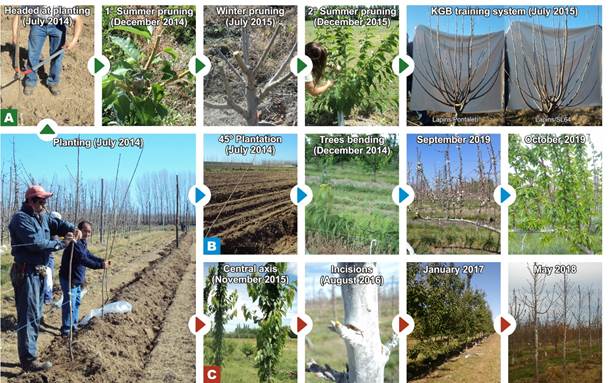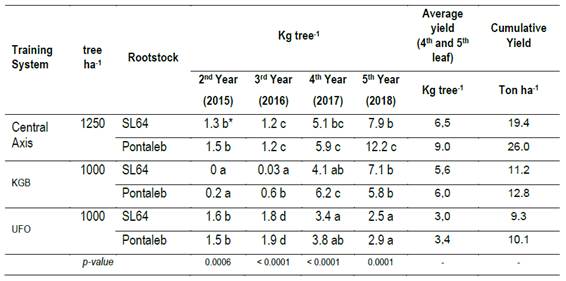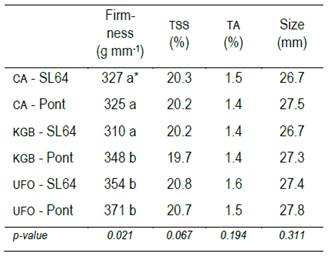1. Introduction
Sweet cherry production in the Río Negro and Neuquén Valleys is an attractive alternative to apples and pears, which were the main production. Fruit growers need technical guidance allowing cost reduction to maintain system profitability through enough yield with adequate fruit quality to reach market requirements. Modern sweet cherry production trends are towards pedestrian orchards1, where rootstock:scion:training system interaction differs markedly2. Therefore, comparative studies of training systems are needed to evaluate yield and fruit quality under specific climatic conditions. Kym Green Bush (kgb) was developed in Australia and it does not need support (lower cost of installation). Tree vigor is controlled by dividing the axis into several temporary vertical axes, and this fact allows the use of a wide range of rootstocks1. The innovative Upright Fruiting Offshoots (ufo) was developed in Washington State University. This system is based on the same concept of fruiting on temporal vertical axes, but it requires a support structure (posts and wires), so it has a higher cost of installation. Both systems were designed to optimize yields and labor efficiency among other purposes. The aim of this trial was to evaluate the behavior of cv. Lapins on ‘sl64’ and ‘Pontaleb’ rootstocks conducted in the kgb, ufo and Central Axis (ca) systems.
2. Materials and Methods
The trial was planted in 2014 at 4 m between rows, with 2.5 m between plants for the kgb and ufo, and 2.5 m for ca systems. Pruning and training work were carried out as required for each system (Figure 1). Eight representative trees were selected and tagged on each training system. Trunk cross sectional area (tcsa) 10 cm above graft union was measured at wintertime. Number of branches per tree were counted in December 2016-17 in the kgb and ufo Systems. Fruit yield by tree was determined annually, and 30 randomly taken fruits were evaluated for fruit quality in 2018 harvest. Fruit size (mm) and firmness (g mm-1) were evaluated using an fta-14 electronic pressure device (güss, South Africa). Total soluble solids (tss) (%) were measured with an Atago® handheld digital refractometer (Atago CO., Ltd.). Fruit juice was also analyzed for total titratable acidity against 0.1 N NaOH to pH 8.2. Pruning labor efficiency was recorded for each system in July 2019. The pruning time per plant of each conduction system was recorded.

Figure 1: Time of planting and training scheme in three training Systems:  Kym Green Bush (kgb),
Kym Green Bush (kgb),  Upright Fruiting Offshoots (ufo) and
Upright Fruiting Offshoots (ufo) and  Central Axis (ca)
Central Axis (ca)
Data were analyzed by analysis of variance (anova) with the statistical software Infostat (Universidad Nacional de Córdoba, Argentina). Means were compared using the lsd Fisher test and only p<0.05 are reported.
3. Results and Discussion
The kgb system was the easiest to implement and it produced the most vigorous plants (Figure 2). Cherry trees on sl64 showed greater vigor than trees on Pontaleb, which indicates that the number of axes per plant in the first combination could be increased, as was previously suggested1.

Figure 2: Trunk cross sectional area (tcsa, cm2) of Lapins sweet cherry trees growing on Santa Lucia 64 (sl 64) and Pontaleb rootstocks in Central Axis (ca), Kym Green Bush (kgb) and Upright Fruiting Offshoots (ufo)
The kgb system was the least precocious, due to the requirement of early pruning for its formation (Figure 1). Lapins/Pontaleb combination was generally more productive than Lapins/sl64 in all training systems, especially in ca and kgb (Table 1).
Table 1: Average yield of Lapins sweet cherry trees grafted onto Santa Lucia 64 (sl 64) and Pontaleb trained to Central Axis (ca), Kym Green Bush (kgb) and Upright Fruiting Offshoots (ufo) in Río Negro

*Means followed by different letters within columns are significantly different according to lsd Fisher’s test (p<0.05).
Moreover, average yield tree-1 was lower than previous reports for each training system1, probably due to the vigorous rootstocks used in this trial. Likewise, it is important to highlight that spring frosts occurred in September 2015 and 20163, that could have affected the early yields of the trees in this trial. In the ufo, expected yields were not reached, probably because many trees did not get the necessary number of developed shoots in the initial years (Figure 3), and also because the development of upright shoots was quite variable, as was previously reported for this cultivar4. Anyway, this cultivar/rootstock combination could be planted at higher density in this system, and thus the yields per hectare might be increased.

Figure 3: Average number of upright shoots per tree in Lapins sweet cherry trees growing on Santa Lucia 64 (sl 64) and Pontaleb rootstocks training as Upright Fruiting Offshoots (ufo) and Kym Green Bush (kgb)
The average number of upright shoots per tree were higher in the kgb than in the ufo systems in both rootstocks (Figure 3). This could explain the higher yield (kg tree-1) observed in both kgb combinations compared to the ufo (Table 1).
The fruit quality results are shown in Table 2. Trees trained to the ufo (planar canopy) and kgb/Pontaleb (the lesser vigorous combinations in kgb) produced fruits with higher firmness. Cherries from these treatments were more exposed to sunlight, which is positively correlated with that parameter5. No differences were found in total soluble solids, titratable acidity and fruit size among the different combinations (Table 2).
Table 2: Average fruit quality parameters of Lapins grafted onto Santa Lucia 64 (sl64) and Pontaleb (Pont) trained to Central Axis (ca), Kym Green Bush (kgb) and Upright Fruiting Offshoots (ufo)

*Means followed by different letters within columns are significantly different according to lsd Fisher’s test (p<0.05).
Furthermore, the kgb and ufo systems reduced labor needed for winter pruning and tying wages by 74 and 48%, respectively, when compared to the ca, as previously reported6. Harvesting and pruning in the kgb system could be done without ladders. Therefore, labor efficiency at harvest was also higher in this system.
4. Conclusions
The kgb and ufo training systems behave appropriately with the semi-vigorous rootstocks used in this trial. Although yields obtained in these systems did not exceed the Central Axis, it is possible to increase planting density and expected yield. These pedestrian systems are promising because they offer an important reduction in pruning and harvesting costs, as main advantages.















